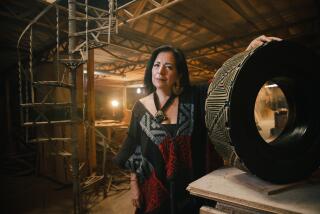Contemporary ‘Mexican’ Art in Show at Two Galleries Doesn’t Fit the Stereotype
- Share via
“Contemporary Mexican Artists,” showing simultaneously at the galleries of Mesa and Palomar colleges through April 27, was originally organized for the University of Southern California to coincide with a major show at the Los Angeles County Museum of Art, “Hispanic Art in the United States.”
One has the sense that the spinoff exhibit is really a salvo launched against a perhaps justified fear that the American public will mistakenly perceive “Hispanic art”--and presumably “Chicano art,” too--as representing all art being created in Mexico.
Reinforcing this apparent defensive posture is the reported discomfort of Mexico City’s Centro Cultural Arte Contemporaneo, organizer of “Contemporary Mexican Artists,” over a discussion to be held tonight at Mesa College on “Both Sides of the Border: Exploring Chicano and Mexican Art.”
Many of the artists in the show also expressed reluctance to participate with panelists such as Victor Ochoa, Michael Schnorr and Salvador Torres, all of whom are artists strongly linked to Hispanic and Chicano sensibilities and whose art directly addresses cultural, social, and political concerns affecting those communities.
On the other hand, what “Contemporary Mexican Artists” wants to demonstrate is that a significant volume of art being produced in Mexico has little or no relation to Chicano concerns; that “contemporary art,” as a stylistic designation, is alive and well in Mexico. The 31 works by five artists on view at Mesa College, and the 68 works by 12 artists at Palomar College make this clear.
What one sees, however, is essentially derivative contemporary art as it is practiced internationally, from Czechoslovakia to Australia, with few works offering any hint that they were produced in Mexico. (This could never be said of Hispanic and Chicano art, especially that which deals with issues arising in the border regions of Mexico and the United States.)
As a result, the show offers the expectable explorations of abstraction and formalism, reiterations of neo-expressionist figuration, indulgences in graffiti, and the usual photographic expositions of quirky and suffering people. Within this set of non-surprises, much of the work is OK, but it isn’t particularly inventive or important in any context beyond its own.
There are some exceptions, however.
There’s a wonderful Spanish feeling and surrealist quality in Salvador Lutteroth’s eight Cibachrome photographic still lifes that variously juxtapose knives, crucifixes, dried fruits, bread crusts, chicken’s feet, candelabra, snakes and metal scraps in lushly colored, eerie compositions. These evoke a sense of eras and attitudes sufficiently old and odd so as to seem unsettlingly alien. Yet we see, or read, these images so easily that they enter and entrance the psyche before the more upsetting qualities of the works can cause the mind to blank out their impact in an act of protective defense.
Also at Mesa College are several assemblages by Adolfo Patino. One of these, “The Sign,” consists of a glass box framed with rulers marked in centimeters and implying order and rationality. Bits of text in Spanish, written on the glass panes and on scraps of paper within the box, suggest dictionary-like functions. Yet the interior of the box is dominated by thousands of tiny, dried alphabet soup letters, which suggest a chaos of language, order and meaning diametrically opposed to the other elements, in both form and implication.
At Palomar College, the most impressive works are Geraldo Suter’s photographs, which juxtapose harsh, angular and often menacing Mayan masks and sculpture with the forms of living human bodies. His “From Earth, Heaven and Hell,” for example, combines a half-human, half-bull mask with a pair of hands held against the mouth of the mask, as if suppressing a statement about to be uttered, or expressing shock at some event occurring in the direction of the camera. In these images, Suter manipulates the black-and-white emulsion to yield soft blues and ocher tones that subtly alter and deepen the strange expression of his photography.
A vision distinctive in another way manifests itself in a pair of large ink-on-paper works by Rocio Maldonado. Her imagery closely explores the details of natural botanical forms as they exist simultaneously above and below ground--as though one can see as clearly through soils and rocks as through air. This, of course, is something that can be done with the artist’s eye, and the results here catch an echo of late Gothic landscape painting in which the details of a scene are depicted separately and in their entirety, not as part of a more realist view in which things are constantly getting in each other’s way.
If these descriptions don’t remind you of anything having to do with Hispanic or Chicano art, that’s the point of the show. And, if you previously assumed that all art in Mexico is Hispanic or Chicano in character, then you now know better. You might also think that, at the bottom line, that “other,” non-internationalist art of Mexican origin or descent is really more exciting and alive because it is more original and engaged with the world. It doesn’t derive from developments evolving elsewhere, but comes from its own roots and is unique.
Concerning the way in which the exhibit is presented--at two galleries miles apart--it’s really more of an inconvenience than a problem. Furthermore, Louise Kirtland and Kathleen Stoughton, directors of the Mesa and Palomar galleries, respectively, deserve credit for having the courage to look beyond an awkward physical arrangement to bring to town an exhibit that’s ultimately more important as a stimulus in the domain of ideas and meanings than as a presentation of what would like to be internationally important art.
For information about tonight’s discussion at Mesa College, and for that galleries hours, call 560-2878. For the Palomar College gallery, call 744-1150, Ext. 2304.
More to Read
The biggest entertainment stories
Get our big stories about Hollywood, film, television, music, arts, culture and more right in your inbox as soon as they publish.
You may occasionally receive promotional content from the Los Angeles Times.










